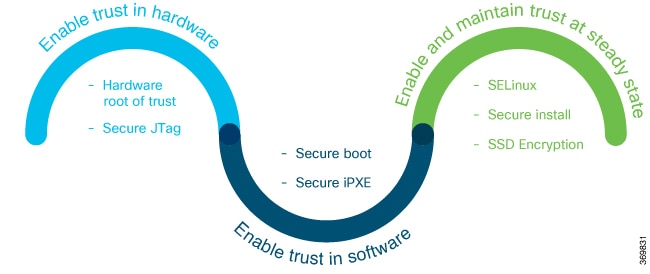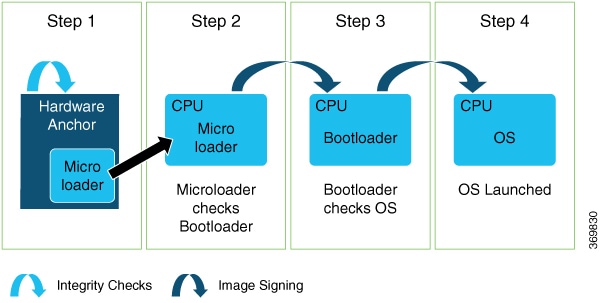Enable Trust in Hardware
Because software alone can’t prove a system's integrity, truly establishing trust must also be done in the hardware using a hardware-anchored root of trust. Without a hardware root of trust, no amount of software signatures or secure software development can protect the underlying system from becoming compromised. To be effective, this root of trust must be based on an immutable hardware component that establishes a chain of trust at boot-time. Each piece of code in the boot process measures and checks the signature of the next stage of the boot process before the software boots.
A hardware-anchored root of trust is achieved through:
-
Anti-counterfeit chip: All modules that include a CPU, as well as the chassis, are fitted with an anti-counterfeit chip, which supports co-signed secure boot, secure storage, and boot-integrity-visibility. The chip ensures that the device's software and hardware are authentic and haven’t been tampered with or modified in any way. It also helps to prevent unauthorized access to the device's sensitive data by enforcing strong authentication and access control policies.
-
Secure Unique Device Identifier (SUDI): The X.509 SUDI certificate installed at manufacturing provides a unique device identifier. SUDI helps to enable anti-counterfeit checks along with authentication and remote provisioning. The SUDI is generated using a combination of the device's unique hardware identifier (such as its serial number or MAC address) and a private key that is securely stored within the device. This ensures that each SUDI is unique and cannot be easily duplicated or forged. When a device attempts to connect to a network, the network uses the SUDI to authenticate the device, and ensure that it’s authorized to connect. This helps to prevent unauthorized access to the network and ensures that only trusted devices are allowed to connect.
-
Secure JTag: The secure JTAG interface is used for debugging and downloading firmware. This interface with asymmetric-key based authentication and verification protocols prevents attackers from modifying firmware or stealing confidential information. Secure JTAG typically involves a combination of hardware and software-based security measures. For example, it may include the use of encryption and authentication protocols to secure communications between the JTAG interface and the debugging tool. It may also involve the use of access control policies and permissions to restrict access to the JTAG interface to authorized users only.
 Note |
Hardware-anchored root of trust is enabled by default on Cisco NCS 540 Series routers. |
Secure Hardware for Strong Cryptography
All Cisco IOS XR7 supported-platforms ships with a non-tamperable Trust Anchor module (TAm) in the hardware.
TAm houses known-good-values (KGVs) of the hardware components along with keys and certificates rooted to Cisco, which are used to verify components of the hardware during the BIOS boot.
Chip Guard and Attestation are security features implemented in TAm.
-
Chip Guard detects tampering attempts and responds by initiating actions such as disabling access to the device, erasing sensitive information stored in the device, or triggering a security alarm.
-
Attestation provides a mechanism for verifying the integrity and authenticity of the software and hardware components of a device.
A Cisco router with SUDI is authenticated and verified remotely for uniquely identifying that it’s an authentic Cisco device.
Where Cisco NCS 540 Series Routers have the older generation of chips with lesser capabilities compared to the latest TAm chips present on the newer generation of hardware.


 Feedback
Feedback